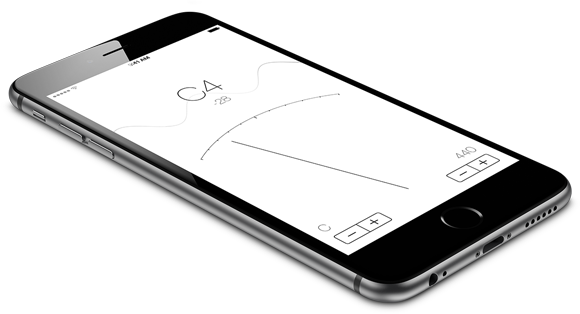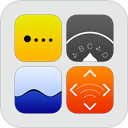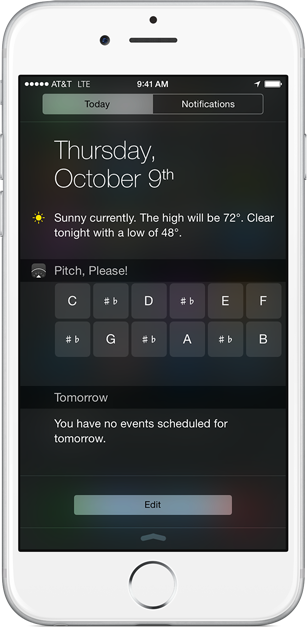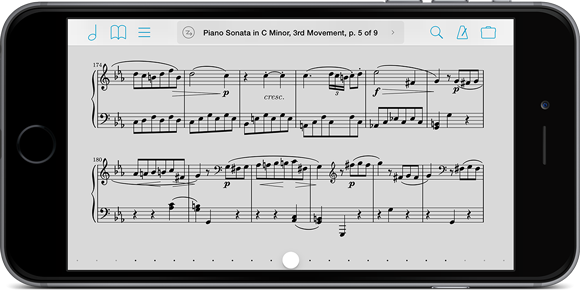Today our app TuneWave was featured in The New York Times! It’s on page B9 of many print editions and a version of the article is also available online. We’re very happy to see our tuner app in the spotlight and we’re grateful to the Times for considering us.
When we introduced our in-app purchase storefront back in 2012, we knew it had the potential to address the needs of our users, artists, and music publishers alike. We knew that by combining the simplicity and ubiquity of standard PDF files with forScore-specific features and enhancements, we could provide a fantastic experience without locking people in.
Our customers could quickly and easily access popular music perfectly optimized for the iPad (and would gladly pay for it). Artists could provide a much more personal product by including their own notes and annotations (we’ve had conversations with a number of musicians over the years looking to do just that). Publishers, of course, could benefit from the incredible popularity of the iPad and give their customers the chance to enjoy sheet music on their own terms.
We’ve had great support from our first few partners including Oregon Catholic Press and Janet Lanier, but our talks with major music publishers over the years have repeatedly stalled. From accounting and formatting requirements to more fine-grained logistical questions, somewhere along the line we meet institutional hesitation. Originally, the biggest sticking point was our choice to not use DRM (Digital Rights Management) since we believe such technologies most often hinder legitimate usage and make customers feel like criminals. Eventually it became clear that this wasn’t something we had enough leverage to influence and we designed a DRM system for publishers to use if they choose to. Yet here we are in 2015 and we still get emails from customers asking why our selection is so limited and if we’ll be adding more music soon.
Ultimately, this is up to the music publishers. They’ve shown that they understand the importance of making their music available on the iPad: many of them have their own apps, though the music they sell is viewable exclusively within their app. We know our customers don’t want to have to remember who supplied the music, switch apps, and then find it and play it. They want to use the music reader they prefer, and they want to have their entire collection available to them at once.
If you’re a forScore user who wants to see more music in our storefront, consider getting in touch with the publishers who sell the kinds of music you’re eager to buy and let them know. As a small company, there’s only so much we can do to convince them. If customers start giving them constructive feedback, they’ll be much more likely to listen.
If you’re an artist, consider the kind of experience you can offer through digital music that you could never offer with paper. Your music could be enhanced, brought to life, and made available to even more musicians with our powerful accessibility tools like Reflow. These musicians might never be able to play your music otherwise.
Finally, if you work for one of these publishers, please contact us. We know we have a lot to offer, and we can’t wait to work with you.
Today we’re very excited and proud to announce the release of forScore mini, the complete forScore experience for iPhone and iPod Touch. It’s been a long process and an incredibly rewarding one, and the final result is a relentless pursuit of the mission forScore started over four years ago: to remove barriers between musicians and their music.
Now, with your entire repertoire in your pocket and the world’s incredibly diverse library of music just a few taps away, there’s no doubt forScore mini fulfills its mission and significantly broadens the variety of ways musicians can benefit from digital sheet music. The music reader that so many people love and depend on every day is now more accessible and versatile than ever, and we can’t wait to hear what you think.
Available immediately and exclusively on the App Store, forScore mini is just $6.99 (USD) so be sure to check it out today!
Today we’re proud to introduce our latest creation: TuneWave. First unveiled as part of forScore 8, TuneWave is a no-nonsense tuner that uses a beautiful sine wave animation to give you a visual sense of focus by reducing amplitude as you zero in on your note. You can transpose as needed and adjust the base frequency to fit your needs, and since it’s a universal app, you can use it on any of your devices.

 That’s not all, though, because today we’re also announcing our first App Bundle, the forScore Music Box. It combines each of our accessory apps into one easy package and offers them for just $2.99 (USD, international pricing varies slightly). That means you can get the brand new TuneWave app for free if you’ve already purchased the other three apps individually! Otherwise, TuneWave is 99 cents when purchased separately.
That’s not all, though, because today we’re also announcing our first App Bundle, the forScore Music Box. It combines each of our accessory apps into one easy package and offers them for just $2.99 (USD, international pricing varies slightly). That means you can get the brand new TuneWave app for free if you’ve already purchased the other three apps individually! Otherwise, TuneWave is 99 cents when purchased separately.
If you haven’t had a chance to check out these apps previously, now’s a great time to do so. From our slick metronome to our recently updated pitch pipe (complete with a ‘today view’ widget for instant access from just about anywhere), it’s a steal. Get TuneWave as part of the new forScore Music Box on the App Store today!
Today we’re happy to announce the immediate availability of forScore 8.1, an incredible update that includes a number of new features, enhancements, and bug fixes.
To start, we’ve added support for iCloud Drive to the Services panel. Due to the way Apple has designed these functions, interactions work differently than they do with other cloud services. Instead of browsing a list of files and uploading or downloading as needed, iCloud Drive interactions are driven by purpose: you begin by choosing to upload or download a file (multiple file operations are not supported by Apple at this time). If you have any apps installed that include a storage provider extension, you can select it within the iCloud Drive interface in the top left-hand corner (called “locations”).
We’ve also made a number of improvements to forScore’s Devices panel, beginning with support for the Adonit Jot Touch and the Wacom Bamboo Fineline. Both of these devices feature hardware buttons, and with forScore 8.1 you can now configure them to invoke any of the common actions found in the “Page turners & shortcuts” section of the settings panel (just like you can currently with the iRig BlueBoard). Not only does it support the Jot Touch’s pair of buttons and the Fineline’s single button, but now also supports the button on the Jot Script.
It doesn’t stop there, though, because we can also detect the difference between a quick click and a longer press and hold (much like forScore’s default annotation shortcut), allowing you to set up two commands per button. That gives you instant access to your top two forScore features with the single-button models, up to four with the Jot Touch, and an incredible twelve on the iRig BlueBoard if you’ve got auxiliary pedals attached.
Finally, we’ve made improvements to drawing accuracy by adjusting our palm rejection algorithms and we’ve added an important new calibration setting to account for differences in handwriting style. Although not perfect, this new setting is the best way we’ve found to account for some severe and complex issues inherent to fine-tipped styli.
Thanks to the hard work of our beta testers and some long nights, we’ve also fixed a number of additional bugs that iOS 8 introduced. We’ve corrected an issue that prevented users from sending some files to other apps, resolved an issue with the Devices panel on the iPad 2, and we’ve greatly improved MIDI connectivity and stability.
Not only that, but forScore 8.1 also happens to be the 100th version of forScore! When we say “free updates for life,” we mean it, so be sure to head over to the App Store today and take advantage of these great new features and important bug fixes (and if you’re on an iPad, be sure to check out our brand new app preview while you’re there, too!)
November 3, 2014
| In Depth, News
In the summer of 2012, over two years ago now, forScore 4 had just hit the App Store and we were beginning to transition forScore over to Core Data. iOS 6 had just been announced, and Apple Maps was gearing up to make waves that still haven’t completely settled down. Since then, we’ve released forScore 5, 6, 7, and now 8, but that’s only half of the story.
This is the story of forScore mini: how we created it, why, and how it reflects the shifts in Apple’s strategy and its priorities. (more…)
We’re very excited to announce that forScore has gone on sale for the first time ever as part of the App Store’s Explore Your Creativity promotion. We’ve never had a sale before, but we just couldn’t miss this opportunity to help even more musicians make the switch to digital sheet music. Right now you can get forScore for a whopping 50% off, but hurry—it won’t last long! Get forScore here and be sure to check out all of the great apps on sale.
Update: This promotion has now ended.
 The pitch pipe widget that we introduced with forScore 8 has proven to be a big hit, and it wasn’t long after people started using it that our suggestion box began filling up with requests for bringing something similar to the small-screen version of our pitch pipe, Pitch, Please! We listened, and with today’s update to version 2.3 we’re doing exactly that.
The pitch pipe widget that we introduced with forScore 8 has proven to be a big hit, and it wasn’t long after people started using it that our suggestion box began filling up with requests for bringing something similar to the small-screen version of our pitch pipe, Pitch, Please! We listened, and with today’s update to version 2.3 we’re doing exactly that.
The widget relies on the app’s settings, so you can simply set the sound, octave, and tone that you want to use within the app, then get instant access to the note you need from just about anywhere. Those settings get pushed from the app to the widget, not the other way around, so you may not hear anything until you run the app and change the octave and sound settings at least once.
Other than that, it’s identical to the iPad version except that it uses two rows of buttons instead of one. It’s a fun and handy enhancement to a great tool, and we think you’ll love it. Check out Pitch, Please! 2.3 on the app store today!
Update: forScore 8.0.4 is available now, please update if you’re using iOS 8.
We work hard to ensure that major updates go as smoothly as possible—both forScore updates and iOS updates. This year, like every year, we downloaded each of the iOS betas on day one and worked incredibly hard to accommodate changes and keep an eye out for bugs. Unfortunately, some issues just don’t come to light until everything goes live. For our users running iOS 8, one particular problem has surfaced and we wanted to take some time to explain what it is, why it happened, and what we’ve done to fix it.
Some users have found that when they turn from one page of a score to the next, what they actually see is a page from a completely different score. With the help of some very patient beta testers, we were able to determine that the problem comes down to one of the most basic parts of iOS itself: user preferences. Most developers use this system to store your settings and environmental information (in our case, the name of the file you’re looking at). In iOS 8, these values occasionally revert to an earlier state without warning.
To be clear, this isn’t an issue with our major forScore 8.0 update. In fact, we’ve had very few issues related to new or updated features. It’s a problem with iOS, and ultimately Apple will need to fix it. Until then, however, we’ve relocated the information we rely on most to mitigate the worst symptoms of this problem. Our 8.0.2 update, which was submitted before we were able to track down this issue, has already been in review for almost two weeks, so we’re waiting for it to be approved before we submit 8.0.3 with these fixes. We’ll be requesting an expedited review for 8.0.3, since this problem is so severe, and we hope to have everything sorted out soon.
We can’t change the fact that these issues exist, but we can and are doing everything we can to respond to them swiftly. Thank you for your patience and continued support.
September 30, 2014
| News
As some great developers once said, some ideas don’t make sense until suddenly they do. Today we’re very excited to give you a first look at a project we’ve been working on for quite some time now: forScore for iPhone.
Since forScore was first introduced we’ve heard from people who, while recognizing the obvious limitations of viewing sheet music on a tiny screen, have wondered if there was a way to combine the ultimate portability and connectivity of an iPhone with the full feature set and speed of the iPad. That’s exactly what we’ve done, and forScore on the small screen is no compromise when it comes to either. It’s lightning fast, and it replicates every single feature of forScore for iPad (except the storefront, due to in-app purchase limitations). It’s not a read-only app, not a mobile companion, it’s the complete forScore experience in your pocket. This was our most important goal when designing forScore mini, and we couldn’t be more proud of the results.

Of course, the 4-inch elephant in the room is the iPhone’s tiny screen size. Thankfully, Apple answered that question for us (as we were hoping they would) with the new iPhone 6 and 6 plus. Suddenly, this idea makes sense. The 4.7 and 5.5-inch screens used in the latest generation of iPhones are a huge step up and really make this a viable product. We won’t be requiring an iPhone 6, but we’ll be strongly recommending one.
Finally, our incredible new layout feature that we introduced with forScore 8, Reflow, is a key part of this mobile experience. Reflow, if you missed our recent post, is an accessibility feature that finds and lays out each system of music in a score end-to-end, creating a sort of horizontal teleprompter experience that lets you significantly increase the size of music on a device. On the iPad, it’s a great enhancement for our customers with vision problems, but on the iPhone it’s essential. It’s what turns a tool for casual review into a full-blown music reader.
This is new territory for us, and we couldn’t be more excited. We’re going to need some help, though, so we’re asking for beta testers to try it out and give us feedback on what works and what doesn’t. If you’re interested, let us know. Otherwise, be sure to check back here as we finish it up and release it later this year.
Update: We have reached our beta tester goal for this version, but we’re working hard to finish forScore mini so everyone can try it out as soon as possible. Thanks for your interest!



